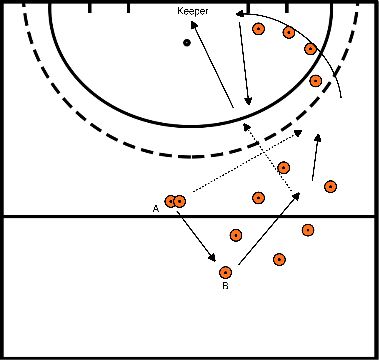Hockey drills for technique hitting
Goal
: The goal of this exercise is to actively pass between the ball and the defender, making yourself playable
Set-up
:In order to run this exercise properly, you need a minimum number of players. You can play with this when you make the exercise one station shorter.
- The player at B starts walking and runs with a curve past the orange pawns. By doing so, he offers himself for play.
- The player at A plays into the run-in player and runs around the indicated cones towards point B.
- The player with C runs in a curve around the orange cones. The moment of starting is important. He pays attention to how far the player at point B is.
- The player at point B plays into the player who left from point C.
- The player at point C receives the ball in front of the orange cones, runs with it into the circle and rounds the goal.
- The player who completed runs around the cones back to point A.
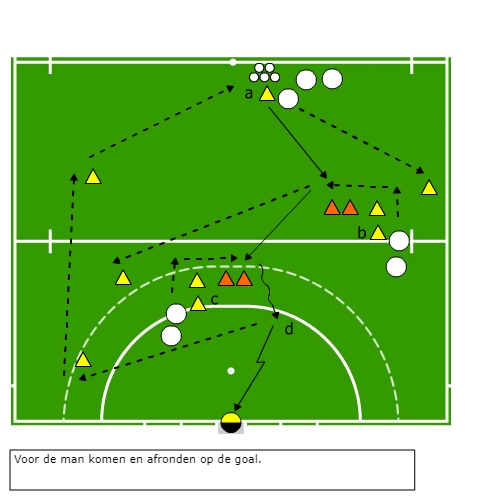
Variations:
- By removing one station, you can make the exercise smaller, requiring fewer players.
- The position from which the player who passes runs in front of the man starts can be changed. You can e.g. move point B more to the inside of the play area, making the direction of play different.
- You can also create an extra station near the goal for someone who is about to tip in Please note that you will need several players for this.
Points of attention:
- When floating, the ball is attached to the stick. This makes it almost impossible to take the ball away without committing a foul.
- When offering the ball, you have to make yourself wide so you can get between the ball and the defender
- Starting the run can be difficult to time, so pay extra attention to this
- The passes should be made in front of the orange cones, so that you are clearly running in front of the man
Passing in the run and finishing on goal
Objective:
Being able to combine, run with and without the ball, turn open, pass and finish on goal.
Set-up:
For the exercise at least 2 participants are active. When you also work with a goalkeeper, a third person is active.
- Player 1 has no ball and starts running from point A to point B.
- Player 2 stands on point E and stays there during the exercise. Player 2 plays the ball to player 1 in the run.
- When player 1 arrives at point B, he plays the ball back to player 2 and continues to point C.
- Player 2 plays the ball to point C so that player 1 can take it there.
- Player 1 turns inside and walks to the head of the circle.
- At point D, player 1 rounds the goal and runs out the exercise on the right side so he can run around point C and take over player 2's spot.
- After handing off player 2's final pass, he runs to point A and closes in at the back.
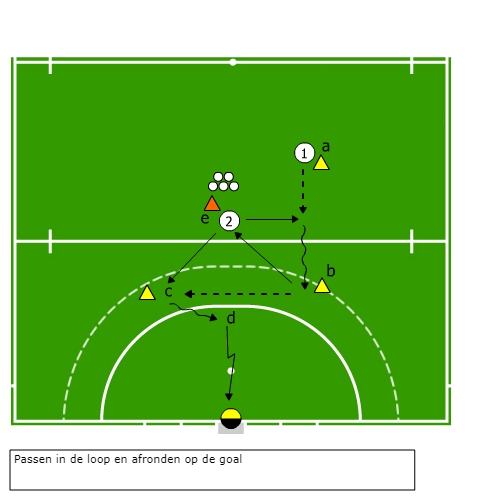
Variations:
- At point B, instead of passing the ball directly to player 2, player 1 can do a Swivel. In this way the player learns to put his body between the ball and the opponent.
- Player 2 can also pass to player 1 in the run from point B to point C. This trains you even more on passing and taking on in the run.
- The whole exercise can also be done in mirror image.
- Instead of one player on point E you can also have two different players make the pass. In that case, after the first pass, player 2 runs through and another player takes the ball and passes it to point C.
- If player 1 is fast enough, player 2 can also bounce the ball from point E to point C. This increases the difficulty by increasing the speed and adding the bounce.
Finish the training with a match shape on a half pitch
You can adjust the width of the field depending on the size of your team at the training.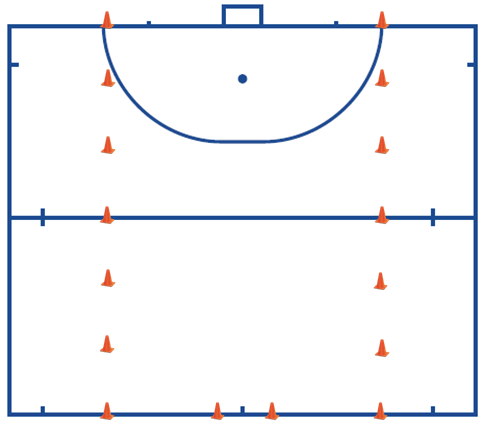
- Position the pawns as shown in the figure
- Spread the balls on pylons C and D.
- In this exercise you place a player on the pylons C and D.
- The rest of the team lines up at the A-post.
- From A the player walks around the pylon
- From the pylon, the player makes a sideways movement, facing the ball (facing C)
- Player C plays the ball into the forehand of A
- A takes the ball and turns to the right to open
- A runs towards the circle and finishes on goal.
- From here he runs to D and receives another ball.
- The player turns open to the left and again finishes on goal.
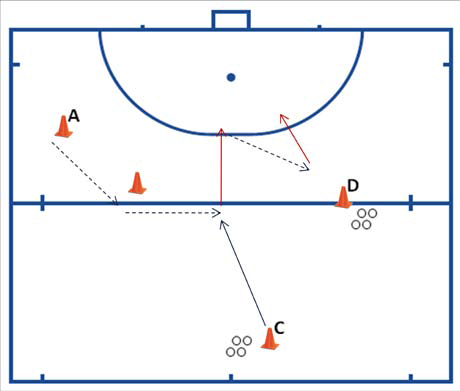

Two teams with substitutes, substitutions are made when a goal is scored.
Each person defends a goal, on each field there are 5 goals, so there are also 5 people who defend these goals.
If a goal is scored in your goal, you have to sit on the sidelines and you become a substitute. A new player (substitute) from the side enters the field and will defend the goal.
If a goal is scored, it is 1 point. The team that has the most points at the end of the game is the winner.
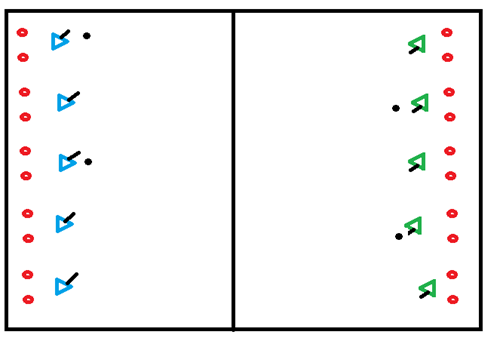
Overplaying to score
Two players continuously play over the ball until one student is so close to the goal that he can score in the goal.
Variation 2-1 situation:
Under pressure from the defender, the attackers must now play together and try to score. The defender can score a point by conquering the ball and then dribbling over the dead ball line. This is the short side without a goal.
Overplaying to score
Two players continuously play over the ball until one student is so close to the goal that he can score in the goal.
Variation 2-1 situation:
Under pressure from the defender, the attackers must now play together and try to score. The defender can score a point by conquering the ball and then dribbling over the dead ball line. This is the short side without a goal.
- A starts with the ball.
- B runs in and gets the ball from A in the run.
- B runs on but meets a defender and passes the ball back to A.
- B then accelerates wide and gets the ball back from A immediately.
- B completes his line and walks in and around the circle with a shot for goal.
- Expanding on two sides
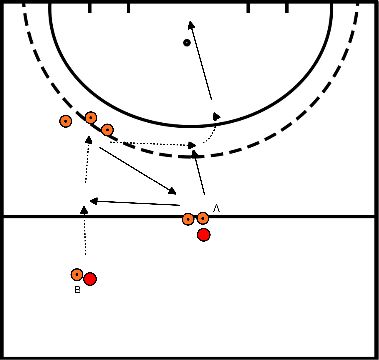
General
- Orange 1 starts with a pass from the sideline to one of the builders (orange 2,3).
- Orange defends out and scores in the goal (A) on the 23 meter line.
- When intercepting or winning a duel by blue (1,2) they score on the big goal (2 blue against 3 orange+k).
- Orange gives direct pressure on blue when losing the ball.
- The exercise starts again after a goal in 1 of the 2 goals, after a maximum of 2 switch moments or when the ball is out.
Tips ball possession
- Make the field wide.
- Take open after scanning the space (by builders).
- Keep depth between both lines (formation 2-1;1-1-1).
Tips non ball possession
- Make a choice between putting direct pressure on the ball owner or letting the opponent come and reducing space.
- Force a passing or running action to the outside (sideline).
- As a goalkeeper, coach the rear build-up player.
- Switching tips
- At Ball Loss:
- Put pressure on the ball holder.
- Play compact and reduce space.
At Ball Profit:
- Preferably play with the ball instead of the ball.
- Make sure there is a quick play point in the depth.
Make it easier
- Build up with 3 players, where the trainer gives the 1st pass to 1 of the 3 Orange players
- Make more difficult
- Provide an evental in players: 3 Orange (with goalkeeper) against 3 Blue (3rd player of Blue starts from the goalkeeper at 23 meters line).
- 1A person on the 23 meters,
- 1B on the back line.
- Both on the left side of the field.
- A scoops to B and runs to head circle.
- B runs to circle edge and plays on A.
- A finishes on goal.
- Blue player receives the ball from the white player each time. (white player distributed)
- Red player runs from stroke point to head circle and receives ball from blue player.
- Red player shoots on goal.
- After each shot he walks back to stroke point and then receives the next ball from head circle.
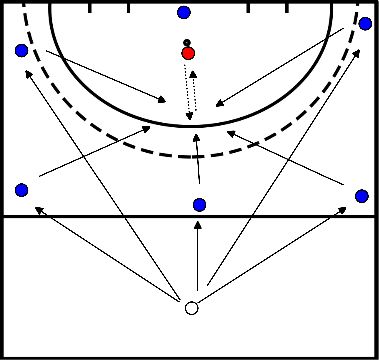
- A starts with the ball one gives a facing pass to B
- B goes through the pilons with a vision dribble
- A runs into the depth and gets a hard targeted pass of B into the depth
- B accelerate around the pilons and give a 90 degree pass on A
- A runs in the direction of the circle and at the height of B so she can receive a 90 degree pass.
- She takes the ball and lines it up and finishes with a hit on goal
